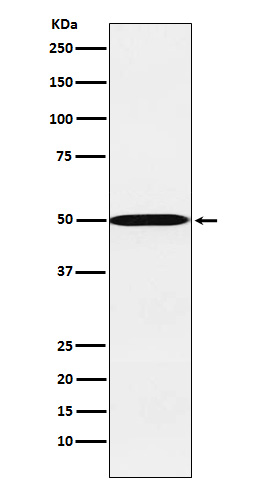CYP26A1 Antibody
Rabbit mAb
- SPECIFICATION
- CITATIONS
- PROTOCOLS
- BACKGROUND

Application
| WB, IHC |
|---|---|
| Primary Accession | O43174 |
| Reactivity | Rat |
| Clonality | Monoclonal |
| Other Names | CP26; CYP26; cyp26a1; hP450RAI; P450RAI; P450RAI1; |
| Isotype | Rabbit IgG |
| Host | Rabbit |
| Calculated MW | 56199 Da |
| Dilution | WB 1:500~1:2000 IHC 1:50~1:200 |
|---|---|
| Purification | Affinity-chromatography |
| Immunogen | A synthesized peptide derived from human CYP26A1 |
| Description | Plays a key role in retinoic acid metabolism. Acts on retinoids, including all-trans-retinoic acid (RA) and its stereoisomer 9-cis-RA. Capable of both 4-hydroxylation and 18-hydroxylation. Responsible for generation of several hydroxylated forms of RA, including 4-OH-RA, 4-oxo-RA and 18-OH-RA. |
| Storage Condition and Buffer | Rabbit IgG in phosphate buffered saline , pH 7.4, 150mM NaCl, 0.02% sodium azide and 50% glycerol. Store at +4°C short term. Store at -20°C long term. Avoid freeze / thaw cycle. |
| Name | CYP26A1 {ECO:0000303|PubMed:26937021, ECO:0000312|HGNC:HGNC:2603} |
|---|---|
| Function | A cytochrome P450 monooxygenase involved in the metabolism of retinoates (RAs), the active metabolites of vitamin A, and critical signaling molecules in animals (PubMed:22020119, PubMed:9228017, PubMed:9716180). RAs exist as at least four different isomers: all- trans-RA (atRA), 9-cis-RA, 13-cis-RA, and 9,13-dicis-RA, where atRA is considered to be the biologically active isomer, although 9-cis-RA and 13-cis-RA also have activity (Probable). Catalyzes the hydroxylation of atRA primarily at C-4 and C-18, thereby contributing to the regulation of atRA homeostasis and signaling (PubMed:22020119, PubMed:9228017, PubMed:9716180). Hydroxylation of atRA limits its biological activity and initiates a degradative process leading to its eventual elimination (Probable). Involved in the convertion of atRA to all-trans-4-oxo-RA. Able to metabolize other RAs such as 9-cis, 13-cis and 9,13-di-cis RA (By similarity) (PubMed:9228017). Can oxidize all-trans-13,14- dihydroretinoate (DRA) to metabolites which could include all-trans-4- oxo-DRA, all-trans-4-hydroxy-DRA, all-trans-5,8-epoxy-DRA, and all- trans-18-hydroxy-DRA (By similarity). May play a role in the oxidative metabolism of xenobiotics such as tazarotenic acid (PubMed:26937021). |
| Cellular Location | Endoplasmic reticulum membrane; Peripheral membrane protein. Microsome membrane; Peripheral membrane protein |
| Tissue Location | Expressed in most fetal and adult tissues with highest levels in adult liver, heart, pituitary gland, adrenal gland, placenta and regions of the brain (PubMed:9826557). Expressed at high levels in lung, pancreas, skin and uterus (at protein level) (PubMed:22020119). Lower expression level is detected in spleen, kidney, intestine and adipose tissue (at protein level) (PubMed:22020119). |

Thousands of laboratories across the world have published research that depended on the performance of antibodies from Abcepta to advance their research. Check out links to articles that cite our products in major peer-reviewed journals, organized by research category.
info@abcepta.com, and receive a free "I Love Antibodies" mug.
Provided below are standard protocols that you may find useful for product applications.
If you have used an Abcepta product and would like to share how it has performed, please click on the "Submit Review" button and provide the requested information. Our staff will examine and post your review and contact you if needed.
If you have any additional inquiries please email technical services at tech@abcepta.com.













 Foundational characteristics of cancer include proliferation, angiogenesis, migration, evasion of apoptosis, and cellular immortality. Find key markers for these cellular processes and antibodies to detect them.
Foundational characteristics of cancer include proliferation, angiogenesis, migration, evasion of apoptosis, and cellular immortality. Find key markers for these cellular processes and antibodies to detect them. The SUMOplot™ Analysis Program predicts and scores sumoylation sites in your protein. SUMOylation is a post-translational modification involved in various cellular processes, such as nuclear-cytosolic transport, transcriptional regulation, apoptosis, protein stability, response to stress, and progression through the cell cycle.
The SUMOplot™ Analysis Program predicts and scores sumoylation sites in your protein. SUMOylation is a post-translational modification involved in various cellular processes, such as nuclear-cytosolic transport, transcriptional regulation, apoptosis, protein stability, response to stress, and progression through the cell cycle. The Autophagy Receptor Motif Plotter predicts and scores autophagy receptor binding sites in your protein. Identifying proteins connected to this pathway is critical to understanding the role of autophagy in physiological as well as pathological processes such as development, differentiation, neurodegenerative diseases, stress, infection, and cancer.
The Autophagy Receptor Motif Plotter predicts and scores autophagy receptor binding sites in your protein. Identifying proteins connected to this pathway is critical to understanding the role of autophagy in physiological as well as pathological processes such as development, differentiation, neurodegenerative diseases, stress, infection, and cancer.


